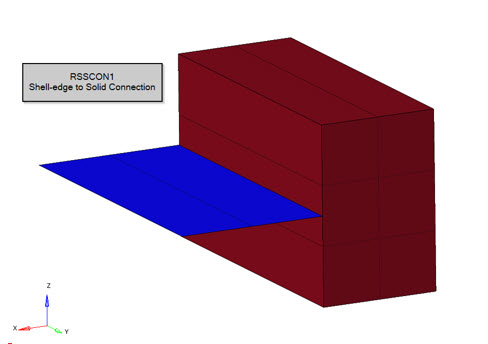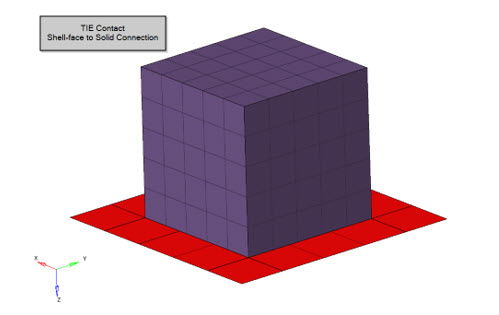Shell to Solid Connection
- RSSCON1 (Surface-based connection)
The RSSCON1 Bulk Data Entry is available and recommended for most shell-to-solid connection requirements. It can be used for shell to solid connections where a shell edge is connected to a solid face.
When shell face is connected to a solid face, a TIE contact can be used for connection.
The RSSCON1 connection internally is implemented via RBE3 elements and is supported for all solutions which support RBE3 Bulk Data.
For the shell edge to solid connection where the thickness of shells are large and kinematic constraints are required to be created for multiple layers on the solid side, then only RSSCON1 is applicable for such a connection.
The RSSCON1 entry is recommended over the older RSSCON entry (MPC-based) as RSSCON1 can handle all the situations that RSSCON could and has additional advantages, including being far easier to setup.
Figure 1. - TIE Contact TIE contact is available for shell to solid connections. RSSCON1 is typically recommended for all shell edge to solid connections, but TIE contact can be used as well. RSSCON1 and RSSCON both assume that the shell is generally perpendicular to the target solid surface. For other cases, for instance, shell face connected to solid face, RSSCON1/RSSCON cannot be used whereas ,TIE contact is available.

Figure 2. - RSSCON (MPC-based connection)
RSSCON generates multipoint constraints (MPC) that models a clamped connection between shell and solid elements. RSSCON1 is now generally recommended over RSSCON.
Table 1. Overview of shell to solid connection methods Connection Type RSSCON1 TIE Contact RSSCON Shell edge to solid face Yes (Recommended) Yes (RSSCON1 is recommended) Yes (RSSCON1 is recommended) Shell edge to solid face (large shell thickness with kinematic constraints required for multiple solid layers) Yes No No Shell face to solid face No Yes No